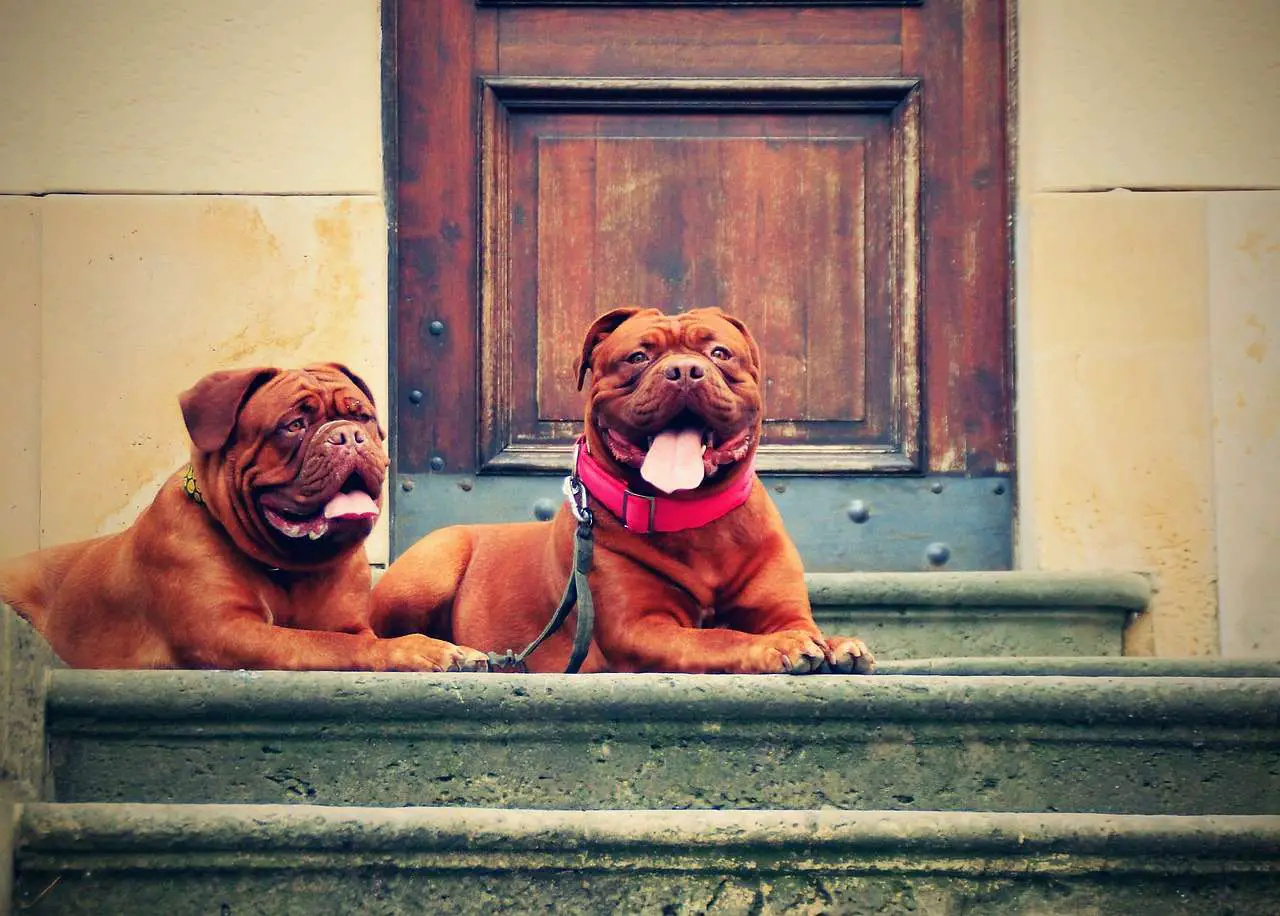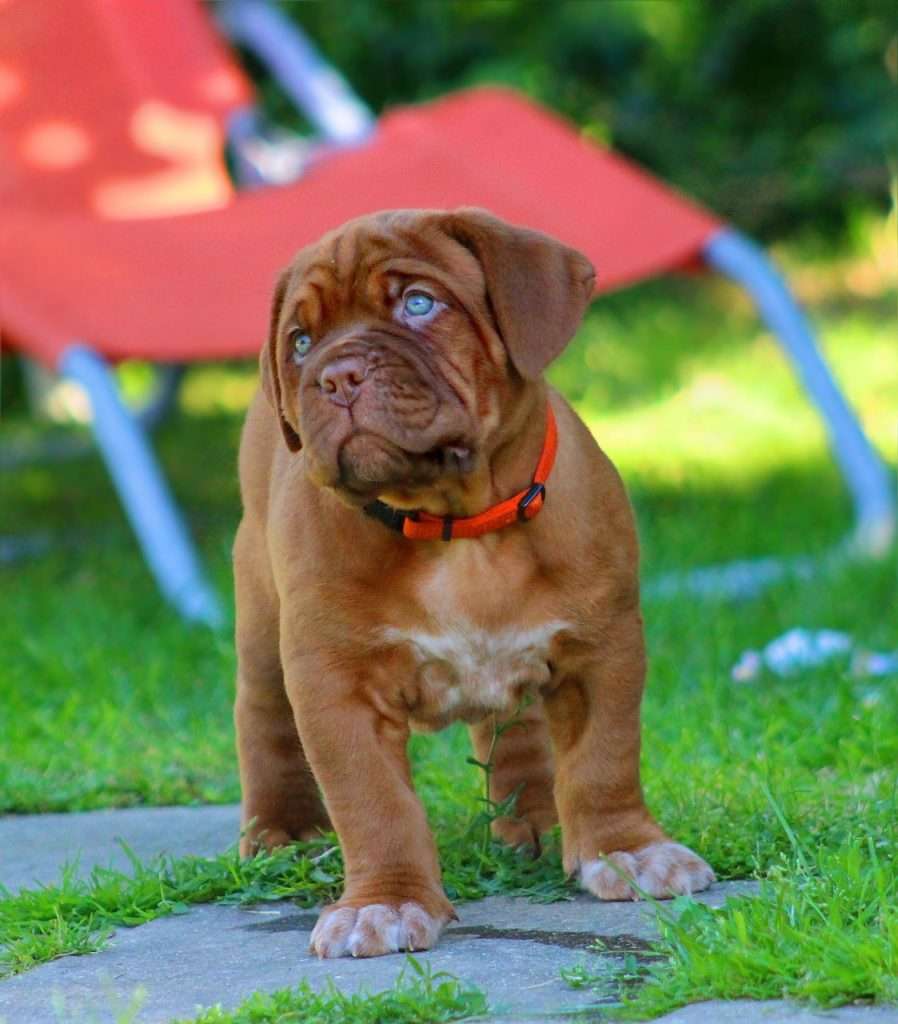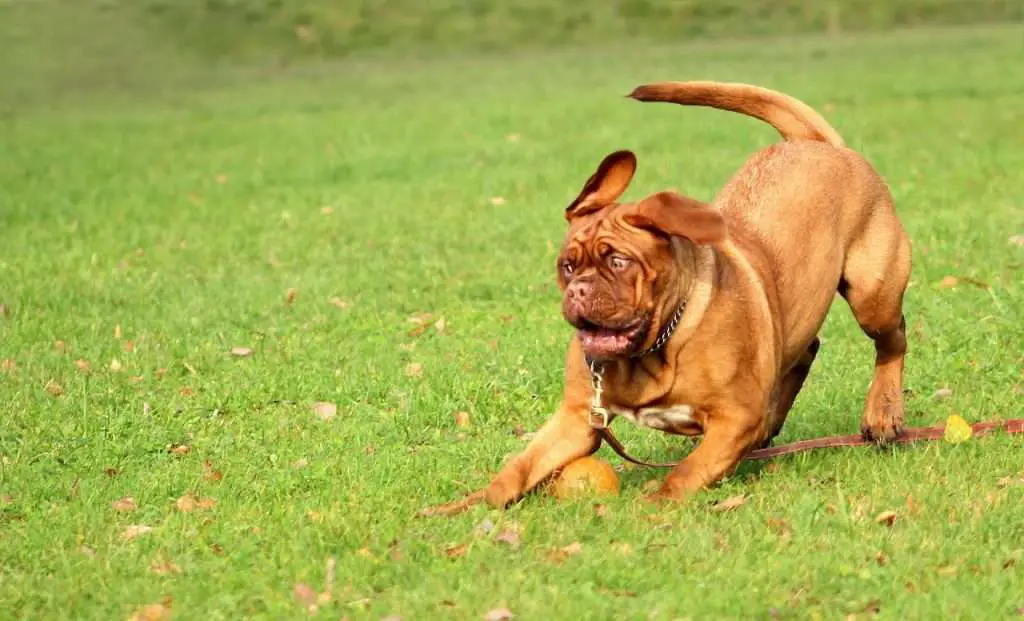The Dogue De Bordeaux Growth Chart

The famously large and easy going Dogue de Bordeaux (French Mastiff), is an ancient breed of Mastiff that has been native to France for hundreds of years and has collected many admirers since it came to fame in the 1989 film Turner & Hooch.
Like many breeds in the Mastiff family, the brawny Dogue de Bordeaux can grow large, pretty fast! You might be asking yourself, how fast? How big will your Dogue de Bordeaux get?
Well, we have created a growth chart to help you plot your dog’s growth from puppy into adulthood.
The genetics of your Dogue de Bordeaux will play a large role in how quickly it grows to the different stages into adulthood. Some are more stocky, some are more gangly as they grow into their frame.
Ultimately, there are many things that may impact the rate of growth and how large your Dogue de Bordeaux eventually ends up. Don’t panic and stick about, as we uncover those variables as we go.
The Dogue de Bordeaux Growth Chart:
All you need in order to use this chart effectively, is an accurate grasp on your dog’s age. If you have had your French Mastiff since a pup, then this should be fairly easy. However, if you’ve inherited or adopted this walking slobber machine, you may want to double and triple check your dog’s age.
Please also keep in mind that these are averages of the breed. A degree of care and common sense is needed to determine if your dog is looking vastly under or over the recorded weight. As ever, if you have your doubts then please do not hesitate to speak to a local and reputable vet.
| Age | Weight (KG) | Weight (lbs) |
| 2 months | 7.7 to 9.5 kg | 17 to 21 lbs |
| 3 months | 14.1 to 17.7 kg | 31 to 39 lbs |
| 4 months | 20.4 to 24.9 kg | 45 to 55 lbs |
| 5 months | 26.3 to 32.2 kg | 58 to 71 lbs |
| 6 months | 31.8 to 39 kg | 70 to 86 lbs |
| 7 months | 34 to 41.7 kg | 75 to 92 lbs |
| 8 months | 35.8 to 44 kg | 79 to 97 lbs |
| 9 months | 37.6 to 46.3 kg | 83 to 102 lbs |
| 10 months | 39 to 48.5 kg | 86 to 107 lbs |
| 11 months | 40.8 to 50.8 kg | 90 to 112 lbs |
| 12 months | 42.2 to 52.2 kg | 93 to 115 lbs |
| 15 months | 46.3 to 57.2 kg | 102 to 126 lbs |
| 18 months | 49.4 to 61.2 kg | 109 to 135 lbs |
| Adult | 54,4 to 63.5 kg | 120 to 140 lbs |
Dogue de Bordeaux Growth Chart Phases – What to expect?
Birth to 2 weeks
The Dogue de Bordeaux can sometimes have a rough start to life. Puppies are born in litters of around 8, many mothers require a caesarean section (around 25%).
The first two weeks are of course crucial, and good breeders should allow mothers to mother their new-borns without too much interference (unless intervention is utterly necessary).
In this phase, you can expect your Dogue to be taking on the nourishment that is key to its development as a healthy pup. They will not yet have proper use of their muscles and limbs and their eyes will remain closed. But don’t worry, those beautiful golden lions eyes will soon open.
3 weeks to 12 weeks
This phase in the Dogue de Bordeaux growth chart is a time full of change and transition. As your little one starts to become more mobile and curious, it will start to interact more with its new environment. As a previous owner of this breed, this is a truly magical spectacle to watch. This is also the perfect time to start socialisation with other humans and animals outside of its siblings.
Up to this point, your DDB will have gotten much of its nourishment for development from its mothers milk. However, in this phase, it’s likely that the dog is starting to eat solid foods.

It’s important to ensure that the right kind of food is being served and in the right portions. Owners need to be aware that at this age, their teeth and gums are sensitive and going through a lot of change. That means food shouldn’t be too hard or too hot.
The addition of real solid foods, along with movement and play lead to a burst in growth rate. At this stage your little French Mastiff should weigh around 40 lbs (for both male and female).
4 Months to 12 Months
Your French Mastiff will undergo many transformations in this period, and soon will start to develop the beginnings of that brawny frame that admirers come to love.
One of the key developments in this period is the packing on of lean muscle mass alongside a growth in bone density and size. You should start to see that famous muscular form start to mature towards the 12 month mark. At this time, most Dogue de Bordeaux’s should reach around 100 lbs in weight.
Owners should keep an eye out for “Pano” (Long bone disease). This is an overproduction of bone, usually visible in the legs due to a high protein diet. It is thought to be fairly painful, but a process that they will eventually grow out of as they mature.
However, if muscle and bone growth are going to occur then this will of course be fueled by a good, nutritious diet. Due to this phase also being key to the development of their teeth and gums, owners can start to experiment with more solid food types, even experimenting with elements of raw or home cooked foods to ensure their dog is getting a full spectrum of nutrients.
It’s important to note that your DDB might also have a knack for chewing things around the house. This may well be down to stimulation but can also have a bit to do with teething. In this phase, we not only recommend feeding more solid food but to also invest in things such as chews, bones and chew toys. Mine loved to play tug of war with rope.
The final aspect of this growth chart phase is the heat cycle. It’s common for this to occur from the 6 month mark. You likely notice behaviour changes alongside other obvious signs such as period blood. From here, it is the owners choice on whether to spay or neuter.
13 Months to Adult
You must be thinking, “when will my Dogue de Bordeaux stop growing?”
French Mastiffs typically hit peak growth between the 18 month to 2 years mark. In most cases, many DDBs will stop growing when they approach the 20 month mark.
However, from the 13 months mark onwards, your companion will start to arrive at its “filling out phase” which isn’t too far from that big, bulky appearance that many owners love about the breed.
At this point, owners should ensure as peak muscle and size is met, calories then start to reduce. This is because your DDB is no longer in its growth phase. Some owners also debate whether you should then start to reduce protein intake, although this may depend on your stance on different diets such as raw vs traditional.
How big will my Dogue de Bordeaux get?
It’s important to note that its peak weight may vary for different reasons, however you can expect your DDB to reach around 120-140lbs, and 23-27 inches in height. A hell of a journey from its tiny puppy form! It should also be said that males tend to be slightly bigger, however this isn’t always the case.
Factors that impact a Dogue De Bordeauxs Growth
A Dogue de Bordeaux can reach somewhere between 120 – 140lbs, that’s a fair amount of difference. There are many things that can affect the size of your Dogue de Bordeaux’s growth. Some of these are in your control and consist of lifestyle elements such as diet and exercise. In general, as a caring pet owner of this distinguished breed, you should be maximising these areas to ensure your pup thrives.
On the other hand, there are also elements which you have no control over such as genetics. And although you can do due diligence with recommended breeders, there’s no hiding the fact that the Dogue de Bordeaux does come with some unfortunate health related issues as it ages.
Diet & Nutrition For Growth
Known for its size and muscular frame, the French Mastiff loves its food, and needs a lot of it!
Owners should pay attention to how they transition the puppy from softer foods to more solid foods as it matures. High quality food and nutrition should be a paramount factor of dog ownership throughout its life.
We recommend speaking to breeders and joining mastiff communities to get an idea of what other successful owners are feeding theirs. Recent trends have shown a move away from grain based foods for dogs (common with kibble) and a move to with raw (80/10/10) diets or home cooked ingredients. This gives the owner full control of ingredients and nutrient intake. However, the drawbacks come down to cost and time.
A note on worming… Ensure your French Mastiff is not carrying worm infections that may result in a struggle to uptake key nutrients from their food. This may result in stunted growth.
Exercise routine For Growth
Dogue de Bordeauxs do not need a whole lot of exercise, which is interesting when taking into account their size and membership to the worker group of dogs. They appear to have a good metabolism which helps keep them in shape.

The breed is prone to joint issues, which means you shouldn’t be going on exceptionally large walks or indulging in high impact activities such as lots of jumping and sprinting.
That said, exercise is still critical for the breed. Not only from a physical standpoint but also for mental stimulation. Regular daily walks should be enough for your pooch, but you should also look for opportunities to play such as tug of war, fetch or food puzzles.
Rest, Sleep & Stress
The Dogue de Bordeaux is a sensitive breed (despite its meaner appearance). This means altercations with other animals or humans may lead to a lot of stress and restlessness. The breed is also prone to overheating, which can lead to a whole host of breathing issues.
Sleep and rest are crucial for proper development. We recommend you keep your home cool and comfortable for your DDB, but also stay tuned in to the emotional needs of your dog. A lack of sleep and rest can lead to slower rates of growth and other onset illnesses further down the line.
Does Spaying or Neutering affect Dogue de Bordeaux growth?
Yes, spaying or neutering can affect the growth of your Dogue de Bordeaux. However, there are things to be aware of along the way, such as neutering a male too early which can lead to a disruption in hormones and therefore growth in a crucial part of their development.
There are of course benefits to spaying and neutering such as avoiding diseases and unwanted pregnancies. The choice is ultimately yours as the pet owner. These questions are better left for a reputable vet.
Does Gender Impact Growth?
Typically male Dogue de Bordeaux’s will be heavier than females. The average male Dogue de Bordeaux can reach up to around 140 lbs, whereas a female is more likely to reach around the 120-125 mark. This is simply a rule of thumb and not universal.
Genetics
The genetics of your Dogue de Bordeaux can of course play a role in its growth. Before committing to a puppy, we recommend quizzing the breeders on average sizes of their litters, whilst also reserving time to meet the parents if possible.
Whilst you’re there, you should also try to quiz the breeders on the common health issues associated with the Dogue de Bordeaux, especially in areas that pertain to growth such as pano.
Hello i have a french mastiff pup wich is now 13 months old .
I was told that the father of french mastiff i have was to big to go over my pups mum so was done through the vet ..
The mother was quite small in regards to a french mastiff ,
My concern is my pup is only about 35kilograms at 13months she was the raunt last 1 left we love the pup regardless just concerned that she wont grow much larger fo you feel that at that weight and age that she might not get any bigger ,
I feed her high protein diet ,
We also now have a male pup that is 5months old and weighs 31kilo already nilly stands same hight and front paws are so much larger
Hey Steven, thanks for the comment and congratulations for devoting yourselves to such a wonderful breed! It’s sad to hear that she isn’t growing as much as you would like and it sounds like you’re dedicated to trying to help her put on more weight. Assuming you’re feeding her enough for her age, it might be worth consulting your vet on things like gastrointestinal issues, parasites or thyroid problems. My Dogue was fairly lanky and skinny at first but this changed over time.